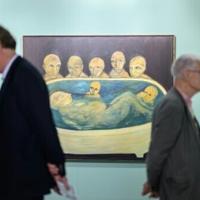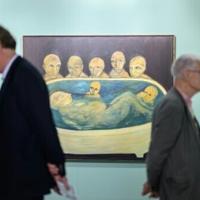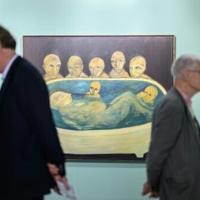Art Market
Arun Kakar
May 30, 2025 3:28PM
798·751 Art District. Courtesy of Gallery Weekend Beijing.
Tariffs, trade wars, and a tricky economic landscape: Such is the backdrop for the global art market as 2025 approaches its halfway point.
This narrative is particularly pervasive when it comes to China. The country was the hardest hit by Donald Trump’s tariffs on imports to the U.S., which rose to as high as 145% in April (China responded with tariffs of up to 125% in response) before negotiations reduced the levies to 30% earlier in May.
While art is understood to be exempt from tariffs, these trade measures can hurt the spending power of the wealthy and affect economic sentiment, which impacts the art market. The trade war came at an already difficult period for China’s art market. The 2025 edition of the Art Basel and UBS Art Market report found that art sales in the country fell by 31% in 2024, causing it to fall behind the U.K. as the world’s third-largest art market.
One might have expected such discussions to cloud the conversations at Gallery Weekend Beijing, but at the ninth edition of the event (held from May 23rd to June 1st), the outlook among collectors and dealers was tentatively optimistic and even defiant. The art scene here is crafting its own narrative: The shows on view and artistic discoveries highlight vibrancy and experimentation, and there is plenty for art lovers to be excited about.
“The general vibe is quite good despite the economic uncertainties,” the Hong Kong-based collector KK Chan told Artsy. “The Gallery Weekend is much busier this year than last year.”
Exterior view of UCCA Center for Contemporary Art. Photo by Brian Jie. Courtesy of the Office for Metropolian Architecture.
Advertisement
Chan is one of many collectors who have travelled across the region for this year’s series of art events. The weekend is centered around the 798·751 Art District—a sprawling cluster of former factory buildings that were transformed into a 148-acre arts complex in 2002. This year, Gallery Weekend Beijing casts itself as part of a new “Beijing Art Season,” bringing together a coalition of arts organizations throughout the city. Also opening during the week was the seventh edition of the Beijing Dangdai Art Fair, which hosted 88 galleries, and the newly rebranded ART021 BEIJING, formerly known as Jingart. ART021 BEIJING runs a longstanding edition in Shanghai in November and launched a new fair in Hong Kong last year; this year it brought together more than 20 exhibitors to Beijing. Also joining the party is the Aranya Art Center with four solo presentations; the center is situated two hours outside Beijing in a beachside resort town of Aranya. For its part, Gallery Weekend is showcasing over 30 local galleries and more than 10 non-profit spaces across the city, from foundations such as the UCCA and Espace Louis Vuitton Beijing through to stalwart galleries such as SPURS and Beijing Commune.
This union of what the organizers called an “extended cultural network” was evident in a buzzy and busy week of events and activities, boosted by ideal gallery-hopping weather: There are worse ways to enjoy a stroll between galleries than with an ice cream in hand. “This synergy has attracted a diverse assembly of professional artists, discerning collectors, and art-curious members of the public, transforming the event into a dynamic hub for artistic exchange and appreciation,” said ShiYing, a director at regional heavyweight Tang Contemporary Art, which operates two spaces in the 798·751 District.
Another smart decision was to make this year’s Gallery Weekend free for galleries to participate in. At the same time, the event has transitioned from an open application system to an invitation-only model to emphasize “curatorial integrity” and “academic focus,” and the result is a series of shows that are perhaps more inclined to take risks with their presentations.
A large chunk of galleries are showing solo or two-person shows, with several taking experimental, conceptual approaches—a bold move in a time where other corners of the art world are leaning into safer propositions amid a testing market.
Tant Yunshu Zhong, installation view of “Unbelievably Soft Process ” at Tabula Rasa. Courtesy of Tabula Rasa Gallery
At Hunsand Space, for example, artist Yang Yang excavates his personal relationship to his upbringing in Inner Mongolia with a series of fragmented works. These take the form of bronze-cast leaves that pile up by the gallery’s entrance, as well as bases made of plaster, etched with pigment and textures that simulate the erosion of grassland.
Yang is one of several emerging artists based in the region who make for rewarding discoveries across the shows on view. Other highlights included Tabula Rasa’s show featuring Tant Zhong, whose assemblages of car washing tools, twisted metal, rubber tubes, and other industrial miscellania evoke road signage and viscera. guo cheng’s hanging sculpture of an insect-like figure crafted from twisted Ethernet cables is the anchor of Magician Space’s show—which won the weekend’s best exhibition award. It takes the word ‘bug’ as a cue to explore the dualities between computer bugs and insects. Vietnamese artist Nguyễn Trinh Thi’s multichannel immersive film installation, 47 Days, Sound-Less (2024), at SPURS, which won the Infinity prize, is another standout. The work positions two projection screens diagonally across from each other, accompanied by a mirror system suspended from the ceiling. In the installation, the artist explores how, in the film Apocalypse Now, villagers from Ifugao, northern Philippines, were cast to stand in for Vietnamese Indigenous peoples. Bringing together chanting of Vietnam’s Jarai people with jungle sound effects drawn from Hollywood war films and misaligned subtitles from science fiction texts, the work is both disorienting and moving.
As well as fresh discoveries, the Gallery Weekend also features no shortage of established names. A dual presentation of works by Megan Rooney and Joan Mitchell at Louis Vuitton’s Espace, a survey of Anicka Yi at UCCA, and a monumental retrospective of Chiharu Shiota at Red Brick Art Museum are among the highlights.
Indeed, there is something for almost every taste here, mirroring what many galleries have described as a “diversifying” domestic collector base. This is particularly being felt by younger collectors from both outside the Chinese capital and across the country, who are drawn to the dynamism of the Beijing scene.
Joan Mitchell and Megan Rooney, installation view of “Painting From Nature” at Louis Vuitton Espace, Beijing. Courtesy of The Estate of Joan Mitchell and Espace Louis Vuitton Beijing.jpg
“Second-generation collectors are now at least 40-50% of our sales,” noted Craig Yee, founder of Ink Studio, which specializes in experimental Chinese ink art. “In particular, what I call globalized Chinese—young Chinese who have gone to school, live, and or worked overseas—seem to immediately recognize the value of our program.”
Many dealers also noted that these younger collectors are interested primarily in Chinese art, reflecting a broader trend in Asia, where collectors are increasingly buying within their domestic art scenes. “Given the [COVID] travel restrictions before, the kind of situations with international trade and shipments, and the current geopolitical situation with the United States, there’s much more focus on artists from China,” said David Tung, director of Lisson Gallery’s Beijing space.
Conversely, this may mirror the broader regional trend of Asian buyers engaging less in the Western art market. In the recent New York auctions, for example, Sotheby’s reported that 10% of buyers in its Modern evening sale—which primarily consists of artworks by Western artists—were from Asia, according to the New York Times. That figure was as high as a third across all auction houses a few years ago.
In Beijing, galleries that are positioning the programs for a domestic audience are the most bullish, too. “We are lucky enough to have a strong local market in China,” said Hadrien de Montferrand, founder of HdM Gallery, which recently expanded its presence in the city. “We sell works by Chinese artists to Chinese collectors and have seen increased interest in recent years.”
Zhao Yinou, installation view of “Ghost Raising” at HdM Gallery Beijing. Courtesy of HdM Gallery.
That’s not to say the Chinese scene is closing off to the international art world. Many of the Chinese artists on view in Beijing are also seeing international interest. At Ink Studio, for example, several artists on its roster are achieving attention abroad, including Bingyi, who has two upcoming shows in New York, and Zheng Chongbin, who earlier this year opened a solo show at LACMA. “Our artists have been extremely active overseas,” Yee asserted.
And it’s worth noting that the Beijing commercial art scene, as many dealers will tell you, is still young compared to other similar-sized art hubs. This is emphasized by a banner year in which a handful of the city’s senior galleries—Galleria Continua, Star Gallery, SPURS, Platform China, and Beijing Commune—all celebrate two decades in business this year. Yet this seniority is a comparative infancy compared to other, more longstanding parts of the global art market. “The oldest auction house [in China] started only 30 years ago—compared to Sotheby’s, for example, which was founded in 1744,” said de Montfort. “The potential of development here is huge.”
Perhaps this is the reason that many in the city are taking a long-term view amid the current economic rollercoaster. Many gallerists are holding firm when it comes to their programming and belief in the artists they are showcasing. While few doubt the difficulties of the current market, they also point to the fact that many issues facing its art market are not exclusive to China. After all, the U.S., according to the Art Basel and UBS report, also experienced a 10% decline in art sales last year.
Chiharu Shiota, installation view of “Metamorphosis of Consciousness” at Red Brick Art Museum. Courtesy of the artist and Red Brick Art Museum
According to many of those in Beijing, this resilience may only be the beginning of the enormous growth potential of the Chinese art market. “The trade, finance, and technology war between the U.S. and China and its impact on world trade has only accelerated a global realignment that has been underway for the past 10 to 20 years,” said Yee.
For him, these broader shifts are working in China’s favor, which he hopes will have a secondary effect on Beijing and its art scene. “Beijing has never been busier nor more important to not just affairs in China, but to world affairs,” he said. “We will see how things develop, but it would not surprise me to see Beijing return to the center stage, at least in the national discourse on art and culture.”
Arun Kakar
Arun Kakar is Artsy’s Art Market Editor.
This post was originally published on this site be sure to check out more of their content




